KPU TMAS 5110: Reflective Paper on Managing Technical Business Growth
VerifiedAdded on 2023/01/09
|9
|2685
|49
Report
AI Summary
This reflective paper, written by a student, explores key concepts in business growth, drawing from course materials and personal experiences. The paper delves into the significance of global strategy, innovation, and the impact of technology on organizational development. It examines the value creation cycle, highlighting the importance of stakeholder management and its relevance in project management. The paper also contrasts the roles of entrepreneurs and intrapreneurs, emphasizing their shared characteristics and distinct responsibilities. Furthermore, it analyzes the influence of technology on organizational development, including the application of Perrow's organizational analysis. The student reflects on personal experiences, connecting theoretical concepts with practical scenarios to provide insights into managing technical business growth.
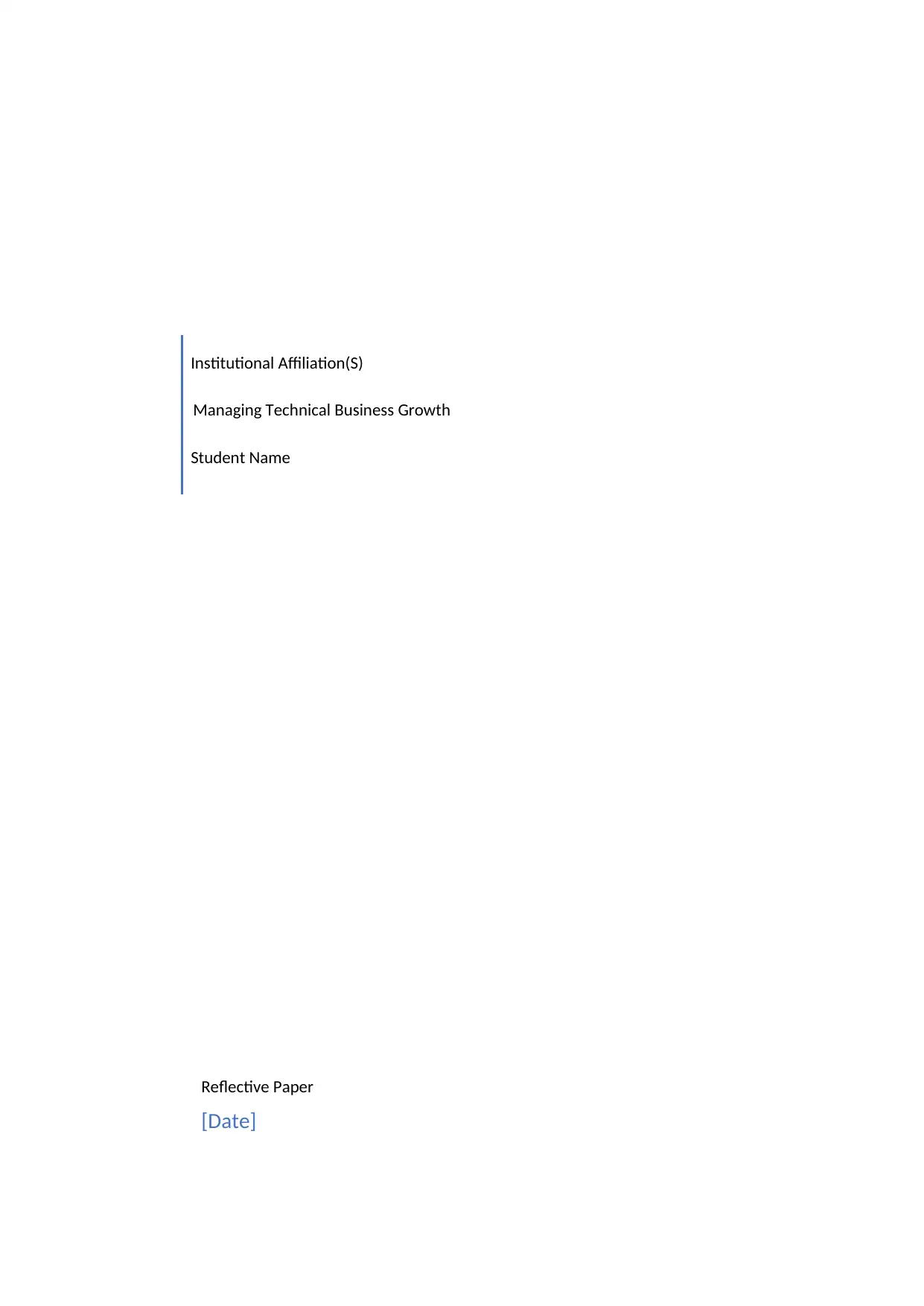
Institutional Affiliation(S)
Managing Technical Business Growth
Student Name
Reflective Paper
[Date]
Managing Technical Business Growth
Student Name
Reflective Paper
[Date]
Paraphrase This Document
Need a fresh take? Get an instant paraphrase of this document with our AI Paraphraser
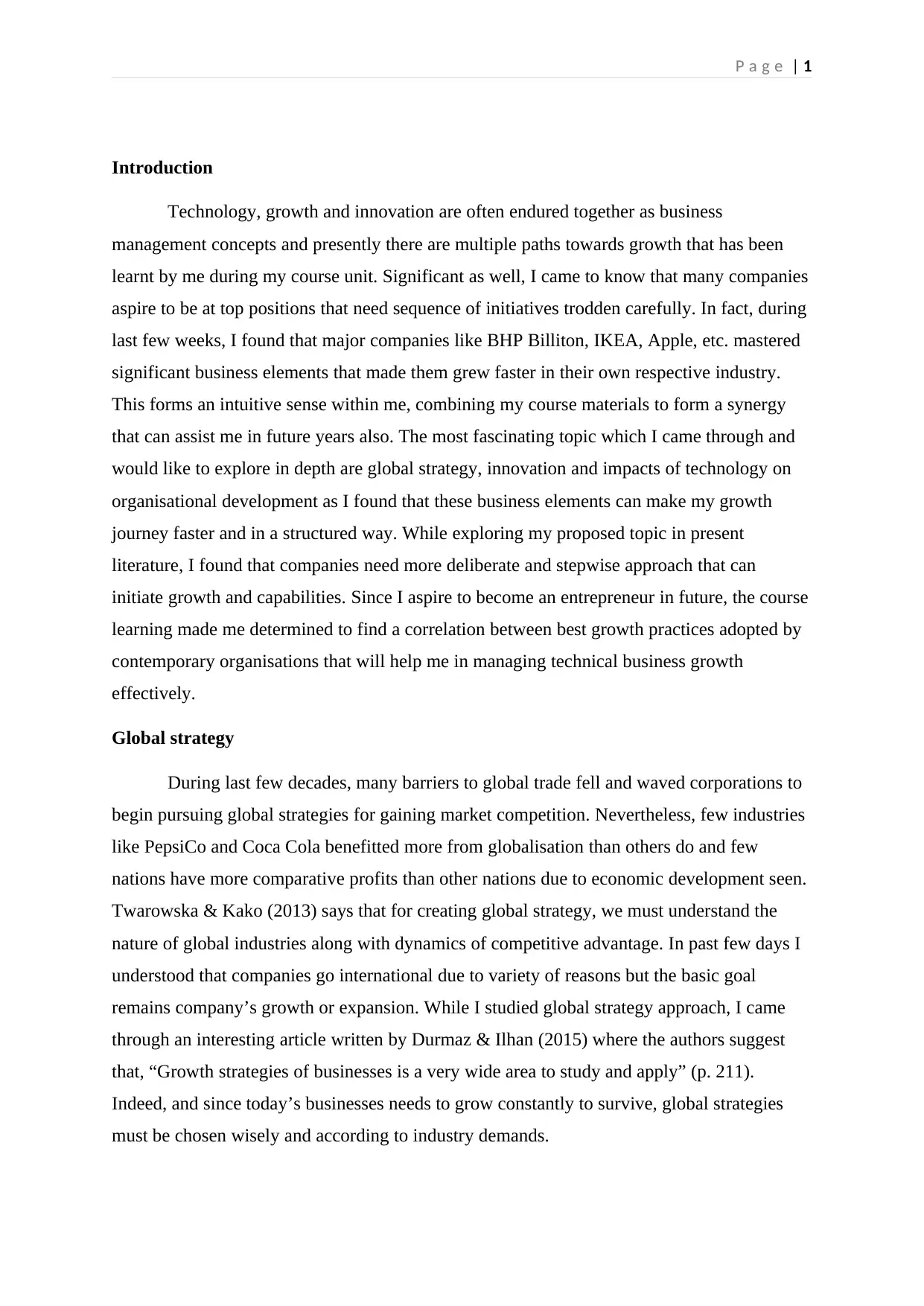
P a g e | 1
Introduction
Technology, growth and innovation are often endured together as business
management concepts and presently there are multiple paths towards growth that has been
learnt by me during my course unit. Significant as well, I came to know that many companies
aspire to be at top positions that need sequence of initiatives trodden carefully. In fact, during
last few weeks, I found that major companies like BHP Billiton, IKEA, Apple, etc. mastered
significant business elements that made them grew faster in their own respective industry.
This forms an intuitive sense within me, combining my course materials to form a synergy
that can assist me in future years also. The most fascinating topic which I came through and
would like to explore in depth are global strategy, innovation and impacts of technology on
organisational development as I found that these business elements can make my growth
journey faster and in a structured way. While exploring my proposed topic in present
literature, I found that companies need more deliberate and stepwise approach that can
initiate growth and capabilities. Since I aspire to become an entrepreneur in future, the course
learning made me determined to find a correlation between best growth practices adopted by
contemporary organisations that will help me in managing technical business growth
effectively.
Global strategy
During last few decades, many barriers to global trade fell and waved corporations to
begin pursuing global strategies for gaining market competition. Nevertheless, few industries
like PepsiCo and Coca Cola benefitted more from globalisation than others do and few
nations have more comparative profits than other nations due to economic development seen.
Twarowska & Kako (2013) says that for creating global strategy, we must understand the
nature of global industries along with dynamics of competitive advantage. In past few days I
understood that companies go international due to variety of reasons but the basic goal
remains company’s growth or expansion. While I studied global strategy approach, I came
through an interesting article written by Durmaz & Ilhan (2015) where the authors suggest
that, “Growth strategies of businesses is a very wide area to study and apply” (p. 211).
Indeed, and since today’s businesses needs to grow constantly to survive, global strategies
must be chosen wisely and according to industry demands.
Introduction
Technology, growth and innovation are often endured together as business
management concepts and presently there are multiple paths towards growth that has been
learnt by me during my course unit. Significant as well, I came to know that many companies
aspire to be at top positions that need sequence of initiatives trodden carefully. In fact, during
last few weeks, I found that major companies like BHP Billiton, IKEA, Apple, etc. mastered
significant business elements that made them grew faster in their own respective industry.
This forms an intuitive sense within me, combining my course materials to form a synergy
that can assist me in future years also. The most fascinating topic which I came through and
would like to explore in depth are global strategy, innovation and impacts of technology on
organisational development as I found that these business elements can make my growth
journey faster and in a structured way. While exploring my proposed topic in present
literature, I found that companies need more deliberate and stepwise approach that can
initiate growth and capabilities. Since I aspire to become an entrepreneur in future, the course
learning made me determined to find a correlation between best growth practices adopted by
contemporary organisations that will help me in managing technical business growth
effectively.
Global strategy
During last few decades, many barriers to global trade fell and waved corporations to
begin pursuing global strategies for gaining market competition. Nevertheless, few industries
like PepsiCo and Coca Cola benefitted more from globalisation than others do and few
nations have more comparative profits than other nations due to economic development seen.
Twarowska & Kako (2013) says that for creating global strategy, we must understand the
nature of global industries along with dynamics of competitive advantage. In past few days I
understood that companies go international due to variety of reasons but the basic goal
remains company’s growth or expansion. While I studied global strategy approach, I came
through an interesting article written by Durmaz & Ilhan (2015) where the authors suggest
that, “Growth strategies of businesses is a very wide area to study and apply” (p. 211).
Indeed, and since today’s businesses needs to grow constantly to survive, global strategies
must be chosen wisely and according to industry demands.
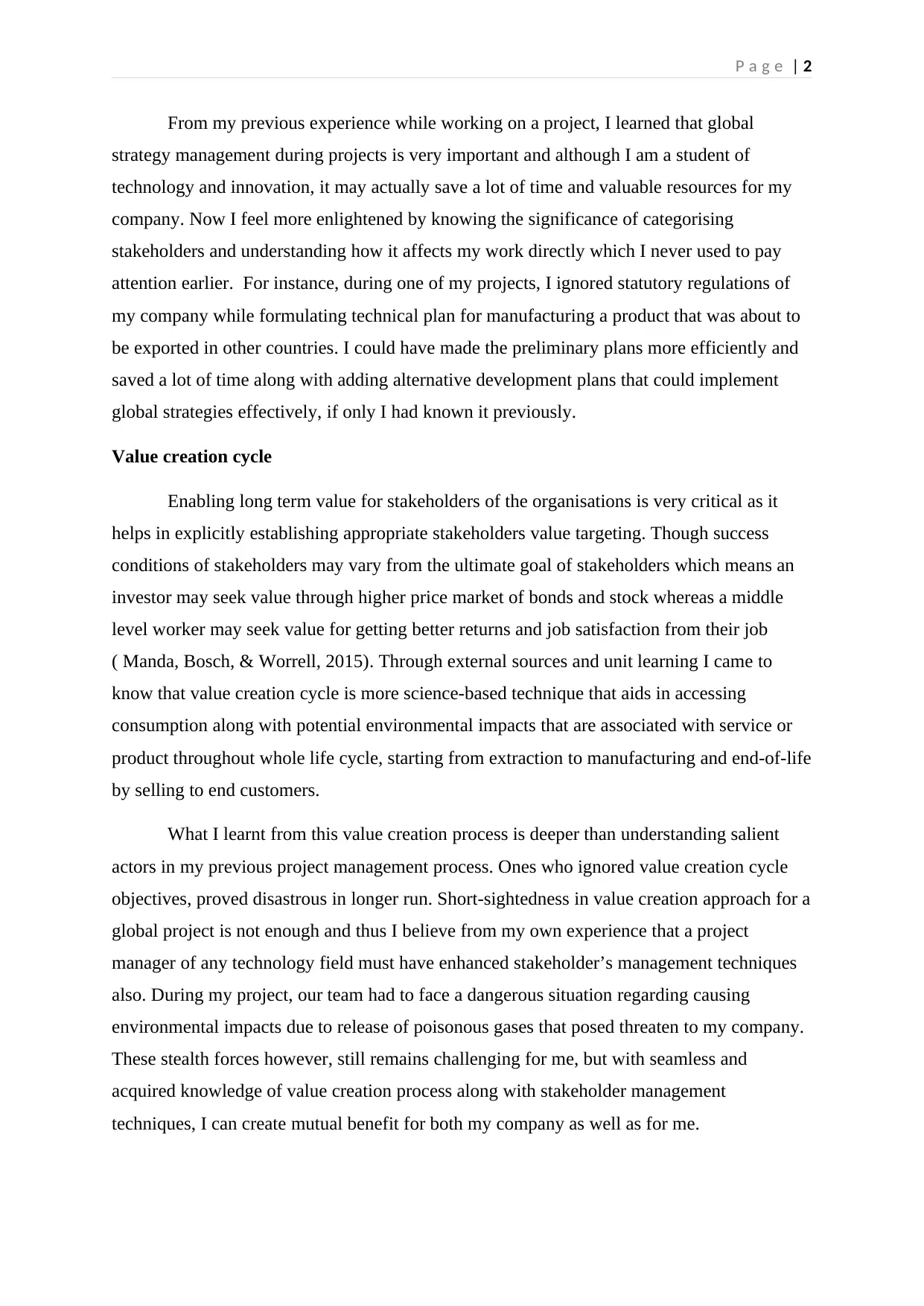
P a g e | 2
From my previous experience while working on a project, I learned that global
strategy management during projects is very important and although I am a student of
technology and innovation, it may actually save a lot of time and valuable resources for my
company. Now I feel more enlightened by knowing the significance of categorising
stakeholders and understanding how it affects my work directly which I never used to pay
attention earlier. For instance, during one of my projects, I ignored statutory regulations of
my company while formulating technical plan for manufacturing a product that was about to
be exported in other countries. I could have made the preliminary plans more efficiently and
saved a lot of time along with adding alternative development plans that could implement
global strategies effectively, if only I had known it previously.
Value creation cycle
Enabling long term value for stakeholders of the organisations is very critical as it
helps in explicitly establishing appropriate stakeholders value targeting. Though success
conditions of stakeholders may vary from the ultimate goal of stakeholders which means an
investor may seek value through higher price market of bonds and stock whereas a middle
level worker may seek value for getting better returns and job satisfaction from their job
( Manda, Bosch, & Worrell, 2015). Through external sources and unit learning I came to
know that value creation cycle is more science-based technique that aids in accessing
consumption along with potential environmental impacts that are associated with service or
product throughout whole life cycle, starting from extraction to manufacturing and end-of-life
by selling to end customers.
What I learnt from this value creation process is deeper than understanding salient
actors in my previous project management process. Ones who ignored value creation cycle
objectives, proved disastrous in longer run. Short-sightedness in value creation approach for a
global project is not enough and thus I believe from my own experience that a project
manager of any technology field must have enhanced stakeholder’s management techniques
also. During my project, our team had to face a dangerous situation regarding causing
environmental impacts due to release of poisonous gases that posed threaten to my company.
These stealth forces however, still remains challenging for me, but with seamless and
acquired knowledge of value creation process along with stakeholder management
techniques, I can create mutual benefit for both my company as well as for me.
From my previous experience while working on a project, I learned that global
strategy management during projects is very important and although I am a student of
technology and innovation, it may actually save a lot of time and valuable resources for my
company. Now I feel more enlightened by knowing the significance of categorising
stakeholders and understanding how it affects my work directly which I never used to pay
attention earlier. For instance, during one of my projects, I ignored statutory regulations of
my company while formulating technical plan for manufacturing a product that was about to
be exported in other countries. I could have made the preliminary plans more efficiently and
saved a lot of time along with adding alternative development plans that could implement
global strategies effectively, if only I had known it previously.
Value creation cycle
Enabling long term value for stakeholders of the organisations is very critical as it
helps in explicitly establishing appropriate stakeholders value targeting. Though success
conditions of stakeholders may vary from the ultimate goal of stakeholders which means an
investor may seek value through higher price market of bonds and stock whereas a middle
level worker may seek value for getting better returns and job satisfaction from their job
( Manda, Bosch, & Worrell, 2015). Through external sources and unit learning I came to
know that value creation cycle is more science-based technique that aids in accessing
consumption along with potential environmental impacts that are associated with service or
product throughout whole life cycle, starting from extraction to manufacturing and end-of-life
by selling to end customers.
What I learnt from this value creation process is deeper than understanding salient
actors in my previous project management process. Ones who ignored value creation cycle
objectives, proved disastrous in longer run. Short-sightedness in value creation approach for a
global project is not enough and thus I believe from my own experience that a project
manager of any technology field must have enhanced stakeholder’s management techniques
also. During my project, our team had to face a dangerous situation regarding causing
environmental impacts due to release of poisonous gases that posed threaten to my company.
These stealth forces however, still remains challenging for me, but with seamless and
acquired knowledge of value creation process along with stakeholder management
techniques, I can create mutual benefit for both my company as well as for me.
⊘ This is a preview!⊘
Do you want full access?
Subscribe today to unlock all pages.

Trusted by 1+ million students worldwide
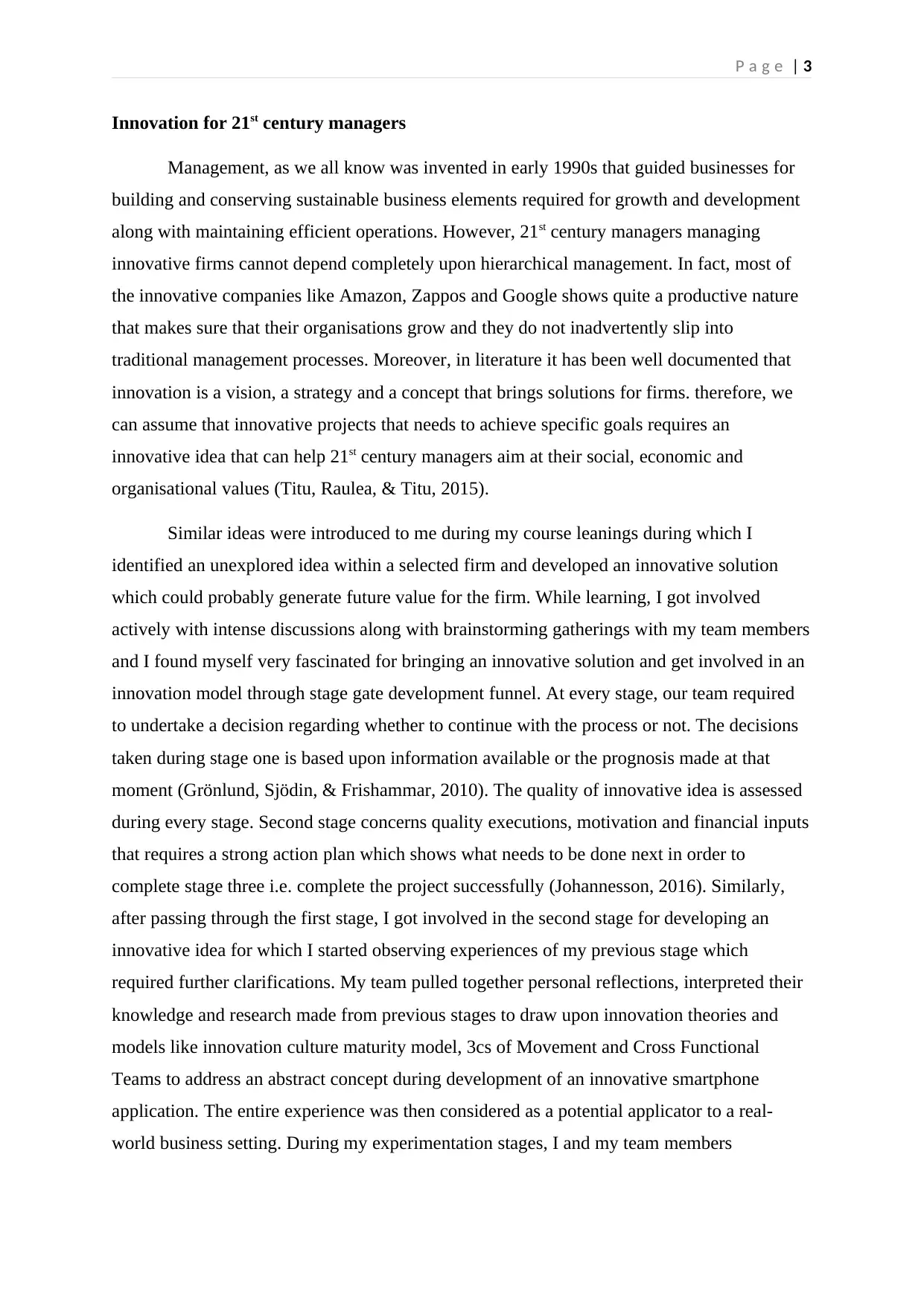
P a g e | 3
Innovation for 21st century managers
Management, as we all know was invented in early 1990s that guided businesses for
building and conserving sustainable business elements required for growth and development
along with maintaining efficient operations. However, 21st century managers managing
innovative firms cannot depend completely upon hierarchical management. In fact, most of
the innovative companies like Amazon, Zappos and Google shows quite a productive nature
that makes sure that their organisations grow and they do not inadvertently slip into
traditional management processes. Moreover, in literature it has been well documented that
innovation is a vision, a strategy and a concept that brings solutions for firms. therefore, we
can assume that innovative projects that needs to achieve specific goals requires an
innovative idea that can help 21st century managers aim at their social, economic and
organisational values (Titu, Raulea, & Titu, 2015).
Similar ideas were introduced to me during my course leanings during which I
identified an unexplored idea within a selected firm and developed an innovative solution
which could probably generate future value for the firm. While learning, I got involved
actively with intense discussions along with brainstorming gatherings with my team members
and I found myself very fascinated for bringing an innovative solution and get involved in an
innovation model through stage gate development funnel. At every stage, our team required
to undertake a decision regarding whether to continue with the process or not. The decisions
taken during stage one is based upon information available or the prognosis made at that
moment (Grönlund, Sjödin, & Frishammar, 2010). The quality of innovative idea is assessed
during every stage. Second stage concerns quality executions, motivation and financial inputs
that requires a strong action plan which shows what needs to be done next in order to
complete stage three i.e. complete the project successfully (Johannesson, 2016). Similarly,
after passing through the first stage, I got involved in the second stage for developing an
innovative idea for which I started observing experiences of my previous stage which
required further clarifications. My team pulled together personal reflections, interpreted their
knowledge and research made from previous stages to draw upon innovation theories and
models like innovation culture maturity model, 3cs of Movement and Cross Functional
Teams to address an abstract concept during development of an innovative smartphone
application. The entire experience was then considered as a potential applicator to a real-
world business setting. During my experimentation stages, I and my team members
Innovation for 21st century managers
Management, as we all know was invented in early 1990s that guided businesses for
building and conserving sustainable business elements required for growth and development
along with maintaining efficient operations. However, 21st century managers managing
innovative firms cannot depend completely upon hierarchical management. In fact, most of
the innovative companies like Amazon, Zappos and Google shows quite a productive nature
that makes sure that their organisations grow and they do not inadvertently slip into
traditional management processes. Moreover, in literature it has been well documented that
innovation is a vision, a strategy and a concept that brings solutions for firms. therefore, we
can assume that innovative projects that needs to achieve specific goals requires an
innovative idea that can help 21st century managers aim at their social, economic and
organisational values (Titu, Raulea, & Titu, 2015).
Similar ideas were introduced to me during my course leanings during which I
identified an unexplored idea within a selected firm and developed an innovative solution
which could probably generate future value for the firm. While learning, I got involved
actively with intense discussions along with brainstorming gatherings with my team members
and I found myself very fascinated for bringing an innovative solution and get involved in an
innovation model through stage gate development funnel. At every stage, our team required
to undertake a decision regarding whether to continue with the process or not. The decisions
taken during stage one is based upon information available or the prognosis made at that
moment (Grönlund, Sjödin, & Frishammar, 2010). The quality of innovative idea is assessed
during every stage. Second stage concerns quality executions, motivation and financial inputs
that requires a strong action plan which shows what needs to be done next in order to
complete stage three i.e. complete the project successfully (Johannesson, 2016). Similarly,
after passing through the first stage, I got involved in the second stage for developing an
innovative idea for which I started observing experiences of my previous stage which
required further clarifications. My team pulled together personal reflections, interpreted their
knowledge and research made from previous stages to draw upon innovation theories and
models like innovation culture maturity model, 3cs of Movement and Cross Functional
Teams to address an abstract concept during development of an innovative smartphone
application. The entire experience was then considered as a potential applicator to a real-
world business setting. During my experimentation stages, I and my team members
Paraphrase This Document
Need a fresh take? Get an instant paraphrase of this document with our AI Paraphraser
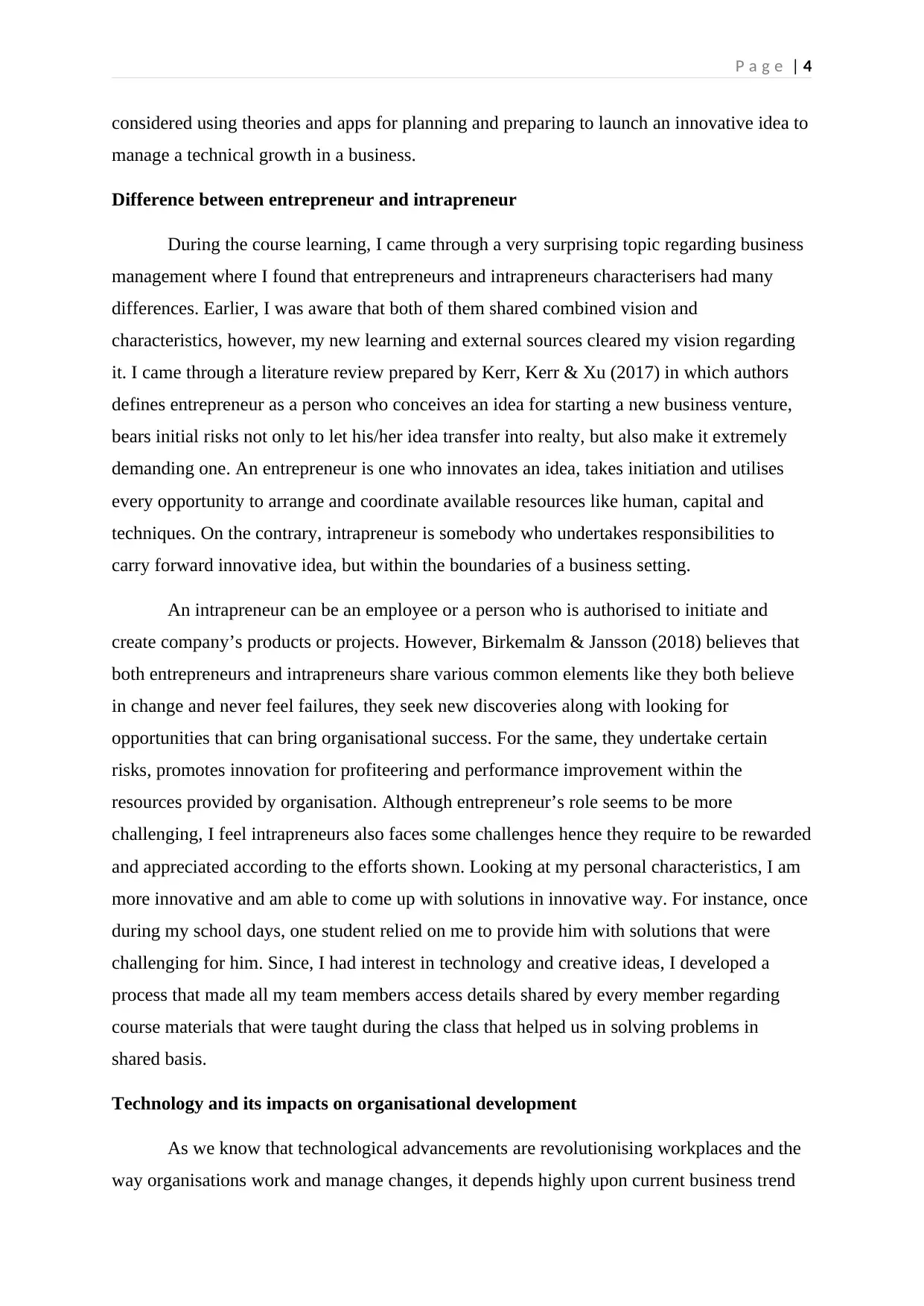
P a g e | 4
considered using theories and apps for planning and preparing to launch an innovative idea to
manage a technical growth in a business.
Difference between entrepreneur and intrapreneur
During the course learning, I came through a very surprising topic regarding business
management where I found that entrepreneurs and intrapreneurs characterisers had many
differences. Earlier, I was aware that both of them shared combined vision and
characteristics, however, my new learning and external sources cleared my vision regarding
it. I came through a literature review prepared by Kerr, Kerr & Xu (2017) in which authors
defines entrepreneur as a person who conceives an idea for starting a new business venture,
bears initial risks not only to let his/her idea transfer into realty, but also make it extremely
demanding one. An entrepreneur is one who innovates an idea, takes initiation and utilises
every opportunity to arrange and coordinate available resources like human, capital and
techniques. On the contrary, intrapreneur is somebody who undertakes responsibilities to
carry forward innovative idea, but within the boundaries of a business setting.
An intrapreneur can be an employee or a person who is authorised to initiate and
create company’s products or projects. However, Birkemalm & Jansson (2018) believes that
both entrepreneurs and intrapreneurs share various common elements like they both believe
in change and never feel failures, they seek new discoveries along with looking for
opportunities that can bring organisational success. For the same, they undertake certain
risks, promotes innovation for profiteering and performance improvement within the
resources provided by organisation. Although entrepreneur’s role seems to be more
challenging, I feel intrapreneurs also faces some challenges hence they require to be rewarded
and appreciated according to the efforts shown. Looking at my personal characteristics, I am
more innovative and am able to come up with solutions in innovative way. For instance, once
during my school days, one student relied on me to provide him with solutions that were
challenging for him. Since, I had interest in technology and creative ideas, I developed a
process that made all my team members access details shared by every member regarding
course materials that were taught during the class that helped us in solving problems in
shared basis.
Technology and its impacts on organisational development
As we know that technological advancements are revolutionising workplaces and the
way organisations work and manage changes, it depends highly upon current business trend
considered using theories and apps for planning and preparing to launch an innovative idea to
manage a technical growth in a business.
Difference between entrepreneur and intrapreneur
During the course learning, I came through a very surprising topic regarding business
management where I found that entrepreneurs and intrapreneurs characterisers had many
differences. Earlier, I was aware that both of them shared combined vision and
characteristics, however, my new learning and external sources cleared my vision regarding
it. I came through a literature review prepared by Kerr, Kerr & Xu (2017) in which authors
defines entrepreneur as a person who conceives an idea for starting a new business venture,
bears initial risks not only to let his/her idea transfer into realty, but also make it extremely
demanding one. An entrepreneur is one who innovates an idea, takes initiation and utilises
every opportunity to arrange and coordinate available resources like human, capital and
techniques. On the contrary, intrapreneur is somebody who undertakes responsibilities to
carry forward innovative idea, but within the boundaries of a business setting.
An intrapreneur can be an employee or a person who is authorised to initiate and
create company’s products or projects. However, Birkemalm & Jansson (2018) believes that
both entrepreneurs and intrapreneurs share various common elements like they both believe
in change and never feel failures, they seek new discoveries along with looking for
opportunities that can bring organisational success. For the same, they undertake certain
risks, promotes innovation for profiteering and performance improvement within the
resources provided by organisation. Although entrepreneur’s role seems to be more
challenging, I feel intrapreneurs also faces some challenges hence they require to be rewarded
and appreciated according to the efforts shown. Looking at my personal characteristics, I am
more innovative and am able to come up with solutions in innovative way. For instance, once
during my school days, one student relied on me to provide him with solutions that were
challenging for him. Since, I had interest in technology and creative ideas, I developed a
process that made all my team members access details shared by every member regarding
course materials that were taught during the class that helped us in solving problems in
shared basis.
Technology and its impacts on organisational development
As we know that technological advancements are revolutionising workplaces and the
way organisations work and manage changes, it depends highly upon current business trend
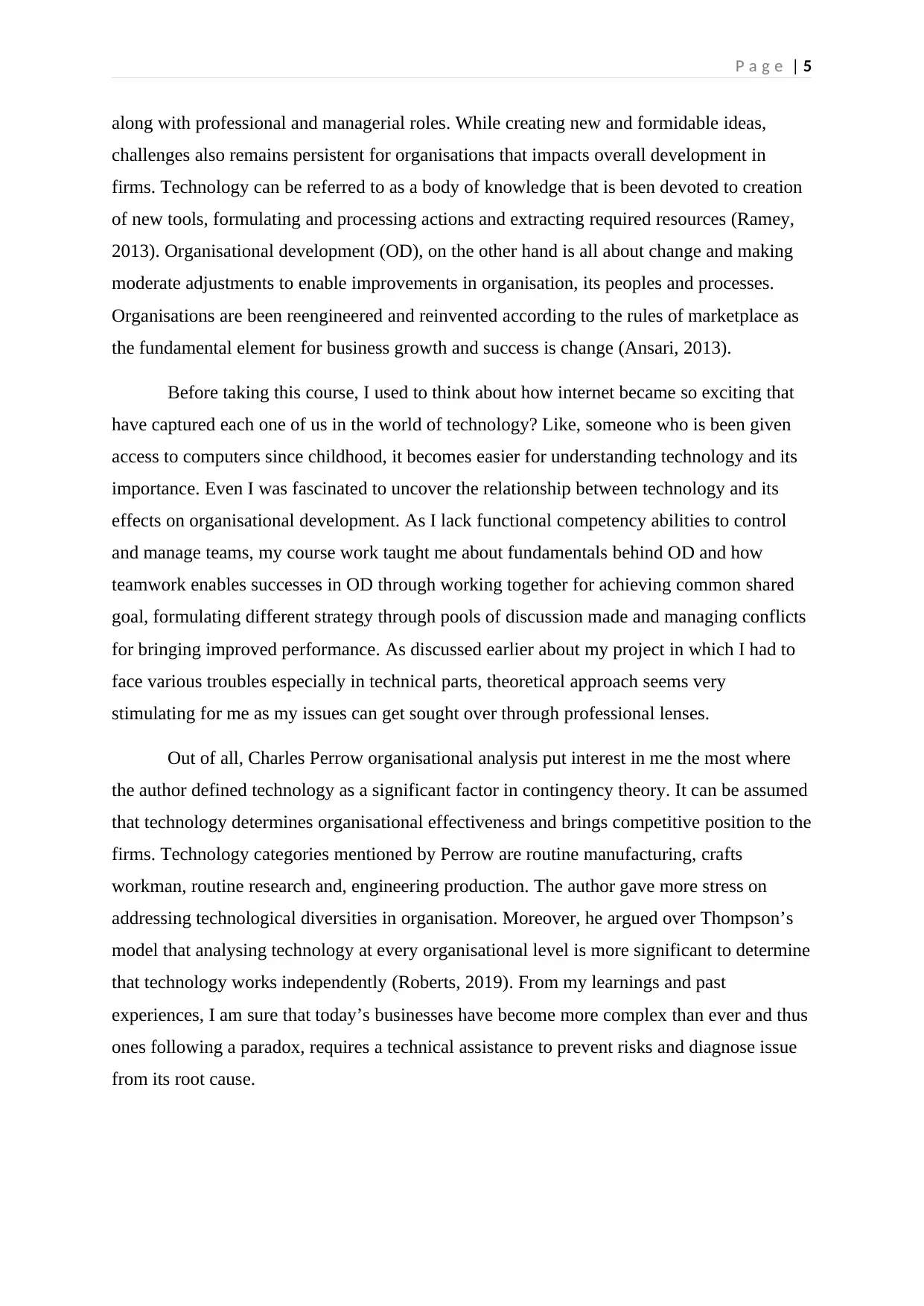
P a g e | 5
along with professional and managerial roles. While creating new and formidable ideas,
challenges also remains persistent for organisations that impacts overall development in
firms. Technology can be referred to as a body of knowledge that is been devoted to creation
of new tools, formulating and processing actions and extracting required resources (Ramey,
2013). Organisational development (OD), on the other hand is all about change and making
moderate adjustments to enable improvements in organisation, its peoples and processes.
Organisations are been reengineered and reinvented according to the rules of marketplace as
the fundamental element for business growth and success is change (Ansari, 2013).
Before taking this course, I used to think about how internet became so exciting that
have captured each one of us in the world of technology? Like, someone who is been given
access to computers since childhood, it becomes easier for understanding technology and its
importance. Even I was fascinated to uncover the relationship between technology and its
effects on organisational development. As I lack functional competency abilities to control
and manage teams, my course work taught me about fundamentals behind OD and how
teamwork enables successes in OD through working together for achieving common shared
goal, formulating different strategy through pools of discussion made and managing conflicts
for bringing improved performance. As discussed earlier about my project in which I had to
face various troubles especially in technical parts, theoretical approach seems very
stimulating for me as my issues can get sought over through professional lenses.
Out of all, Charles Perrow organisational analysis put interest in me the most where
the author defined technology as a significant factor in contingency theory. It can be assumed
that technology determines organisational effectiveness and brings competitive position to the
firms. Technology categories mentioned by Perrow are routine manufacturing, crafts
workman, routine research and, engineering production. The author gave more stress on
addressing technological diversities in organisation. Moreover, he argued over Thompson’s
model that analysing technology at every organisational level is more significant to determine
that technology works independently (Roberts, 2019). From my learnings and past
experiences, I am sure that today’s businesses have become more complex than ever and thus
ones following a paradox, requires a technical assistance to prevent risks and diagnose issue
from its root cause.
along with professional and managerial roles. While creating new and formidable ideas,
challenges also remains persistent for organisations that impacts overall development in
firms. Technology can be referred to as a body of knowledge that is been devoted to creation
of new tools, formulating and processing actions and extracting required resources (Ramey,
2013). Organisational development (OD), on the other hand is all about change and making
moderate adjustments to enable improvements in organisation, its peoples and processes.
Organisations are been reengineered and reinvented according to the rules of marketplace as
the fundamental element for business growth and success is change (Ansari, 2013).
Before taking this course, I used to think about how internet became so exciting that
have captured each one of us in the world of technology? Like, someone who is been given
access to computers since childhood, it becomes easier for understanding technology and its
importance. Even I was fascinated to uncover the relationship between technology and its
effects on organisational development. As I lack functional competency abilities to control
and manage teams, my course work taught me about fundamentals behind OD and how
teamwork enables successes in OD through working together for achieving common shared
goal, formulating different strategy through pools of discussion made and managing conflicts
for bringing improved performance. As discussed earlier about my project in which I had to
face various troubles especially in technical parts, theoretical approach seems very
stimulating for me as my issues can get sought over through professional lenses.
Out of all, Charles Perrow organisational analysis put interest in me the most where
the author defined technology as a significant factor in contingency theory. It can be assumed
that technology determines organisational effectiveness and brings competitive position to the
firms. Technology categories mentioned by Perrow are routine manufacturing, crafts
workman, routine research and, engineering production. The author gave more stress on
addressing technological diversities in organisation. Moreover, he argued over Thompson’s
model that analysing technology at every organisational level is more significant to determine
that technology works independently (Roberts, 2019). From my learnings and past
experiences, I am sure that today’s businesses have become more complex than ever and thus
ones following a paradox, requires a technical assistance to prevent risks and diagnose issue
from its root cause.
⊘ This is a preview!⊘
Do you want full access?
Subscribe today to unlock all pages.

Trusted by 1+ million students worldwide
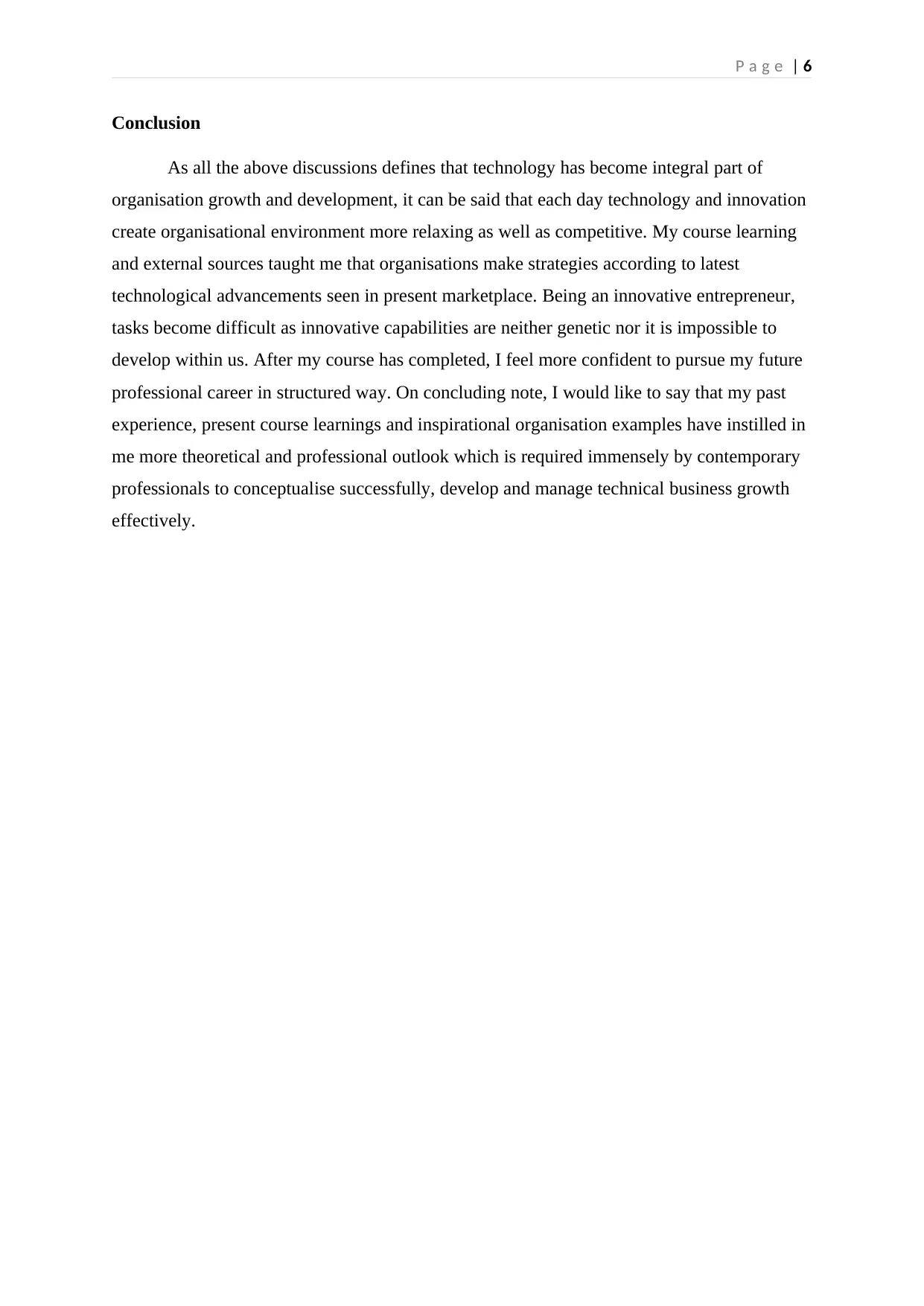
P a g e | 6
Conclusion
As all the above discussions defines that technology has become integral part of
organisation growth and development, it can be said that each day technology and innovation
create organisational environment more relaxing as well as competitive. My course learning
and external sources taught me that organisations make strategies according to latest
technological advancements seen in present marketplace. Being an innovative entrepreneur,
tasks become difficult as innovative capabilities are neither genetic nor it is impossible to
develop within us. After my course has completed, I feel more confident to pursue my future
professional career in structured way. On concluding note, I would like to say that my past
experience, present course learnings and inspirational organisation examples have instilled in
me more theoretical and professional outlook which is required immensely by contemporary
professionals to conceptualise successfully, develop and manage technical business growth
effectively.
Conclusion
As all the above discussions defines that technology has become integral part of
organisation growth and development, it can be said that each day technology and innovation
create organisational environment more relaxing as well as competitive. My course learning
and external sources taught me that organisations make strategies according to latest
technological advancements seen in present marketplace. Being an innovative entrepreneur,
tasks become difficult as innovative capabilities are neither genetic nor it is impossible to
develop within us. After my course has completed, I feel more confident to pursue my future
professional career in structured way. On concluding note, I would like to say that my past
experience, present course learnings and inspirational organisation examples have instilled in
me more theoretical and professional outlook which is required immensely by contemporary
professionals to conceptualise successfully, develop and manage technical business growth
effectively.
Paraphrase This Document
Need a fresh take? Get an instant paraphrase of this document with our AI Paraphraser
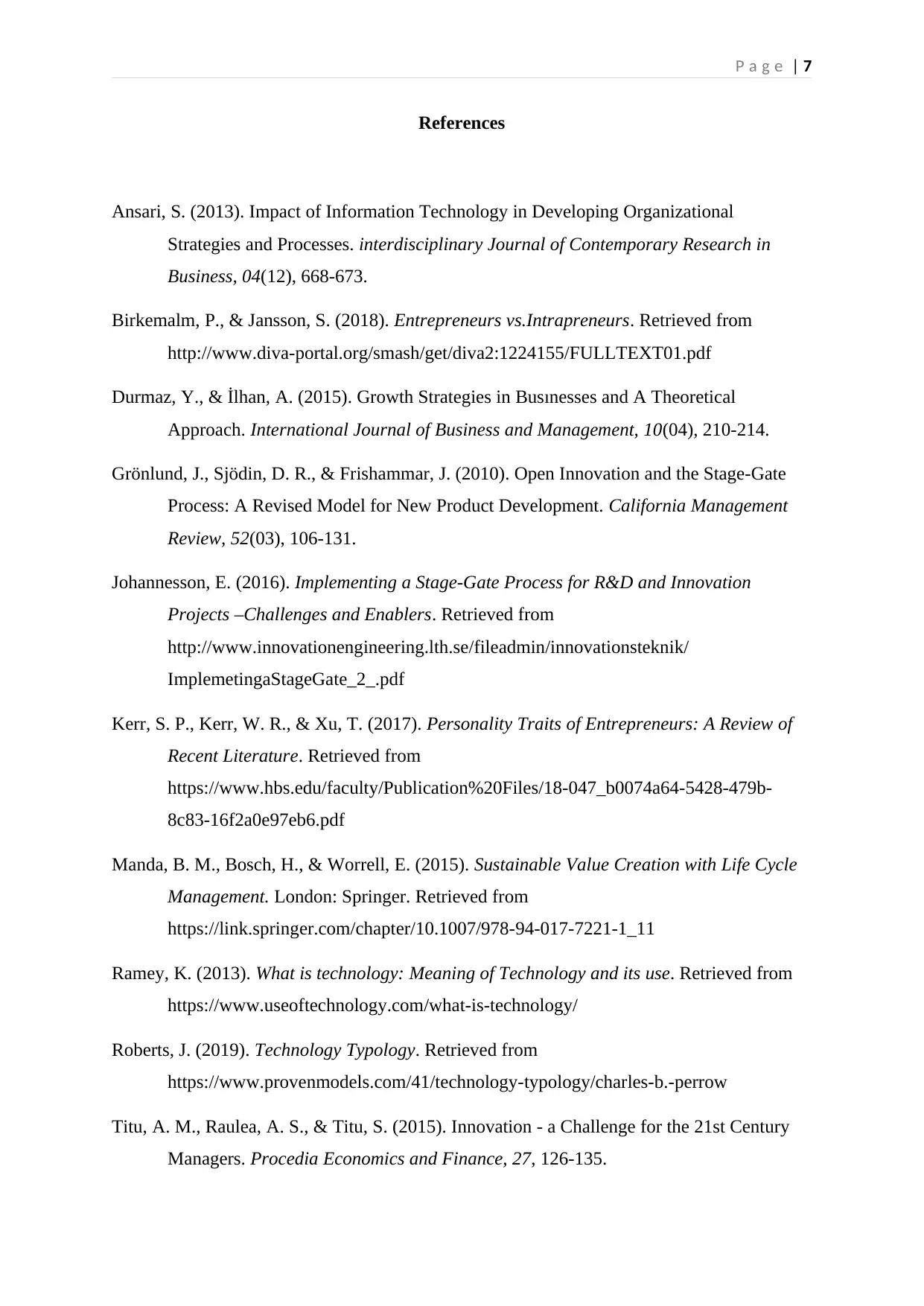
P a g e | 7
References
Ansari, S. (2013). Impact of Information Technology in Developing Organizational
Strategies and Processes. interdisciplinary Journal of Contemporary Research in
Business, 04(12), 668-673.
Birkemalm, P., & Jansson, S. (2018). Entrepreneurs vs.Intrapreneurs. Retrieved from
http://www.diva-portal.org/smash/get/diva2:1224155/FULLTEXT01.pdf
Durmaz, Y., & İlhan, A. (2015). Growth Strategies in Busınesses and A Theoretical
Approach. International Journal of Business and Management, 10(04), 210-214.
Grönlund, J., Sjödin, D. R., & Frishammar, J. (2010). Open Innovation and the Stage-Gate
Process: A Revised Model for New Product Development. California Management
Review, 52(03), 106-131.
Johannesson, E. (2016). Implementing a Stage-Gate Process for R&D and Innovation
Projects –Challenges and Enablers. Retrieved from
http://www.innovationengineering.lth.se/fileadmin/innovationsteknik/
ImplemetingaStageGate_2_.pdf
Kerr, S. P., Kerr, W. R., & Xu, T. (2017). Personality Traits of Entrepreneurs: A Review of
Recent Literature. Retrieved from
https://www.hbs.edu/faculty/Publication%20Files/18-047_b0074a64-5428-479b-
8c83-16f2a0e97eb6.pdf
Manda, B. M., Bosch, H., & Worrell, E. (2015). Sustainable Value Creation with Life Cycle
Management. London: Springer. Retrieved from
https://link.springer.com/chapter/10.1007/978-94-017-7221-1_11
Ramey, K. (2013). What is technology: Meaning of Technology and its use. Retrieved from
https://www.useoftechnology.com/what-is-technology/
Roberts, J. (2019). Technology Typology. Retrieved from
https://www.provenmodels.com/41/technology-typology/charles-b.-perrow
Titu, A. M., Raulea, A. S., & Titu, S. (2015). Innovation - a Challenge for the 21st Century
Managers. Procedia Economics and Finance, 27, 126-135.
References
Ansari, S. (2013). Impact of Information Technology in Developing Organizational
Strategies and Processes. interdisciplinary Journal of Contemporary Research in
Business, 04(12), 668-673.
Birkemalm, P., & Jansson, S. (2018). Entrepreneurs vs.Intrapreneurs. Retrieved from
http://www.diva-portal.org/smash/get/diva2:1224155/FULLTEXT01.pdf
Durmaz, Y., & İlhan, A. (2015). Growth Strategies in Busınesses and A Theoretical
Approach. International Journal of Business and Management, 10(04), 210-214.
Grönlund, J., Sjödin, D. R., & Frishammar, J. (2010). Open Innovation and the Stage-Gate
Process: A Revised Model for New Product Development. California Management
Review, 52(03), 106-131.
Johannesson, E. (2016). Implementing a Stage-Gate Process for R&D and Innovation
Projects –Challenges and Enablers. Retrieved from
http://www.innovationengineering.lth.se/fileadmin/innovationsteknik/
ImplemetingaStageGate_2_.pdf
Kerr, S. P., Kerr, W. R., & Xu, T. (2017). Personality Traits of Entrepreneurs: A Review of
Recent Literature. Retrieved from
https://www.hbs.edu/faculty/Publication%20Files/18-047_b0074a64-5428-479b-
8c83-16f2a0e97eb6.pdf
Manda, B. M., Bosch, H., & Worrell, E. (2015). Sustainable Value Creation with Life Cycle
Management. London: Springer. Retrieved from
https://link.springer.com/chapter/10.1007/978-94-017-7221-1_11
Ramey, K. (2013). What is technology: Meaning of Technology and its use. Retrieved from
https://www.useoftechnology.com/what-is-technology/
Roberts, J. (2019). Technology Typology. Retrieved from
https://www.provenmodels.com/41/technology-typology/charles-b.-perrow
Titu, A. M., Raulea, A. S., & Titu, S. (2015). Innovation - a Challenge for the 21st Century
Managers. Procedia Economics and Finance, 27, 126-135.

P a g e | 8
Twarowska , K., & Kąko, M. (2013). International Business Strategy Reasons and Forms of
Expansion into Foreign Market. Retrieved from
http://www.toknowpress.net/ISBN/978-961-6914-02-4/papers/ML13-349.pdf
Twarowska , K., & Kąko, M. (2013). International Business Strategy Reasons and Forms of
Expansion into Foreign Market. Retrieved from
http://www.toknowpress.net/ISBN/978-961-6914-02-4/papers/ML13-349.pdf
⊘ This is a preview!⊘
Do you want full access?
Subscribe today to unlock all pages.

Trusted by 1+ million students worldwide
1 out of 9
Related Documents
Your All-in-One AI-Powered Toolkit for Academic Success.
+13062052269
info@desklib.com
Available 24*7 on WhatsApp / Email
![[object Object]](/_next/static/media/star-bottom.7253800d.svg)
Unlock your academic potential
Copyright © 2020–2025 A2Z Services. All Rights Reserved. Developed and managed by ZUCOL.





